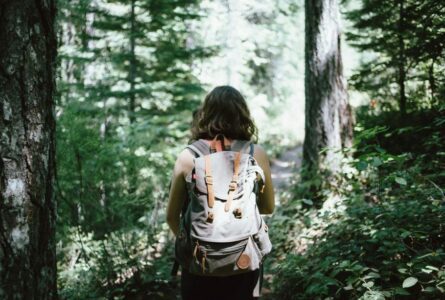The sight of a snake, even if it is non-venomous, can freak out even the most fearless hiker.
The probability of such frightening encounters is higher during hiking trips because you’re stepping foot in their territory.
However, you cannot let ophidiophobia homebound you and prevent you from enjoying the beauty of wildlife.
Learn How to Repel Snakes While Hiking
There are a couple of precautionary measures that you can follow to steer clear of slithery snakes so that you can enjoy your outdoor adventure to the fullest.
-
Appropriate Clothing
The importance of snakeproof hiking apparel cannot be emphasized enough. Going on a hiking trip without wearing protective garments is like offering yourself as the next piece of flesh to the inhabitant snakes of that terrain to dig their fangs into. Wear appropriate apparel, such as hiking or snakeproof boots and snake gaiters, to shield the lower parts of your anatomy that are most vulnerable to snakebites. It is prudent to wear denim or tough jean pants to form an extra protective layer because you never know when you might encounter a snake that could reach your thighs or upper torso.
-
Follow the Established Trails
Don’t let “Dora the Explorer” in you get the best of you. Although taking the road less traveled is ambitious and brave, it is downright foolishness in this scenario. Snakes could be hiding anywhere, which gives them a perfect opportunity to stay concealed till the last moment when you have no way to protect yourself against their attack. But, the established trails have fewer snake-friendly hiding spots. Staying on a hiking trail will keep you out of the way of the hidden slithery creatures. So, no matter how tempted you’re to take a shortcut, climb a rock or wade through a mossy area to reach some deserted waterfall, don’t do it because such places are favourite relaxing spots of snakes.
-
Keep a Hiking Pole or Stick
The more you’re armoured, the safer you will be. Having a hiking pole or stick in hand enables you to remove a snake from your path without getting too close. You need to keep as much distance between you and a snake as possible.
-
Look for Hidden Snakes Before Removing Rocks or Debris
Species like rattlesnakes are masters of camouflage. They wait for the prey to come closer by blending themselves with the surroundings to strike when you least expect it. Clusters of shrubs, patches of tall grass and piles of rocks and logs are some hot favourite shelters of snakes. Carefully scrutinise rocks, woodpiles, piles of leaves or grass before relocating them or sitting on them to avoid unintentionally poking a snake.
-
Look for Snake Warning Signs
Warning signs like “Beware of Snakes” or “Snake Crossing” are for your safety. Keep an eye out for such warning calls. These signs point out those places where the cold-blooded reptiles like to bask in the sun to toast their bodies. So, don’t ignore these safety warning signs, and steer clear of the areas pointed in them.
-
Avoid Disturbing a Snake
Don’t poke the bear! Yep, that’s right. Don’t get befooled by a snake that appears as still as death. If you see a snake, either dead or just resting, move past it as if you didn’t see it. Even a half-dead snake can strike. If you hear signs, such as hissing, huffing, coiling, rattling etc., they’re warnings that the terrifying creature is somewhere close. Make a detour or go back the way you came. It is better to curb your investigative instinct and not to provoke them into attacking you.
-
Hike in Specific Timings
There are parts of the day when snakes are more active. For instance, they bask in the sunshine to warm their bodies. That doesn’t mean they sleep at night like us humans. Instead, they remain active during nighttime coldness to keep the blood flow to stay comfortably warm. The likelihood of an ugly encounter with a snake is higher at night since darkness prevents you from watching out your steps. Choose early morning or evening time for hiking to avoid running into these terrifying creatures. Note that the possibility of snake encounters significantly rises during warmer seasons, i.e. from late spring to early fall.
-
Avoid Hiking Alone
Never go for a hike alone. Always take a hiking buddy with you so that you have a backup in case things go south. Having company is crucial as your partner can rescue you when you accidentally get bitten by a snake. He can give you emergency aid to buy time to safely take you to a nearby medical facility for proper medical treatment. Besides, always carry a cell phone so that you can call for help in case of crisis.

